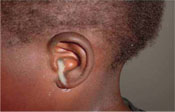35.2.3 Clinical manifestations, diagnosis and complications of acute otitis media
The symptoms and signs of AOM are highly variable, especially in infants and young children. As a health worker in the community, you should check the following symptoms in children with upper respiratory tract infections:
- Ear pain, often manifested by irritability (the child is easily upset) and occasionally holding or tugging at the ear
- A change in sleeping or eating habits
- Symptoms associated with upper respiratory tract infection, such as a runny nose and sneezing typical of the common cold
- Hearing loss, which may manifest as changes in speech patterns; however, this often goes undetected if hearing loss is mild or in one ear only, especially in younger children.
You can diagnose AOM by careful history-taking and physical examination. Ask the child’s caregiver about any history of the above symptoms of AOM. Examine the ear thoroughly for redness or pus discharging from the ear canal (Figure 35.5).

Acute otitis media may progress to produce other complications. These include chronic otitis media, manifested by pus discharging from the ear for more than two weeks, which can lead to permanent deafness.
What is the complication called if the bacteria that cause otitis media infect the membranes surrounding the brain? How serious is this complication?
You learned in Study Session 3 in Part 1 of this Module that bacterial meningitis is a potentially life-threatening infection of the brain, which can also spread and cause an epidemic.
35.2.2 Causes, transmission and risk factors for acute otitis media
